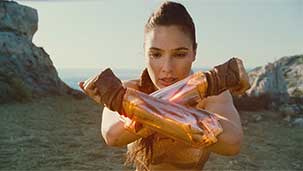A lot of the hype surrounding Wonder Woman has had to do with its progressive trappings: A $240 million film directed by a woman! The first female lead in a blockbuster superhero film! Women’s-only screenings taking place around the world! And to be honest, that’s what led me to write to you. After all, your job was traditionally seen as a woman’s job - so much so that the its original, official title was Script Girl. I’m sure you’d agree that Script Supervisor is a definite (and inclusive) improvement. So here’s to progress, right?
Let’s not get too far ahead of ourselves.
For all its bold pronouncements, Wonder Woman is still a superhero movie, and therefore a studio tent-pole film, which means it needs to reign back lofty ambitions with careful world (a.k.a franchise) building. More specifically, it’s a superhero film that’s part of the nascent DC Extended Universe overseen by Zack Snyder. That’s a pretty stacked deck.
Let’s start with the good, though, which I’m happy to report outweighs the less-than-good by a decent margin. Most importantly, Gal Gadot brings a level of charisma to said Wonder Woman that I hadn’t felt since Christopher Reeves’ Superman. Chris Pine also provides a fine sparring partner for Gadot, proving he can flirt with more than just Vulcan first officers, and helps ground their chemistry in something approaching authenticity, instead of the obligatory box-ticking these relationships often feel like.
In fact, you must have been leafing through the script in disbelief during the early outdoor scenes set on the mythical, Amazon-only inhabited Themyscira, an island which seems specifically designed to blow up the Bechdel Test. Talk about a breath of fresh air. Not only does it feature fully-realized female characters with individual identities and agency (Connie Nielsen and Robin Wright especially make strong impressions), it has something else new: color.
I don’t mean that metaphorically, even though the Amazonian cast is made up of welcome mix of skin colours and ethnicities. No, I mean there is literally colour in these scenes. Heretofore, Snyder’s testosterone-driven vision of the DC universe, in both Man of Steel and Batman v. Superman: Dawn of Justice, has been notable for desaturated colors and night scenes that render action incomprehensible. It’s a depressing but undeniable fact that a simple choice like this represents progress in today’s Hollywood.
In these opening scenes, it’s as if director Patty Jenkins is stating her intent to move forward through colour palette alone. If this sounds too out-there as a read on the film, Jenkins goes even further. As the film moves from Themyscira to World War I-ravaged Europe (and more conventional story tropes), the palette becomes darker, less saturated. Yet Gadot’s Wonder Woman remains a vibrant colourful presence — again, literally — colour-timed to pop out of the muddy backgrounds. This is not a coincidence.
As a script supervisor, I know color correction consistency is not the type of continuity for which you are responsible – your focus is ensuring scene-to-scene (and often shot-to-shot) on-screen continuity for the likes of costumes, make-up, and props. And even though ’script’ is in your title, its quality is not your purview. which may be for the best: as a story, Wonder Woman is ... fine. As it moves towards its climax, Wonder Woman really does become more and more conventional. The motivations of the central villains, German officers Dr. Poison and Ludendorff, are as muddy as the No Man’s Land trenches Gadot and Pine’s crew find themselves dredging through. And what wants to be a late-film plot twist is telegraphed far in advance by casting alone, robbing it of any urgency.
For a film that wants to be seen as mold-breaking as it’s heroine is seen by stiff-lipped Edwardian society, it doesn’t have the faith of its convictions. By the time Wonder Woman had become two mostly-CGI characters lunging, spinning, and smashing into each other in what feels like an endless climax, I felt my enthusiasm being swallowed by the poorly-lit, undefined computer backdrop the characters fight against.* Wonder Woman gains access to the superhero boys club by mimicking its predecessors, not redefining them.
Was the ending Snyder wresting control of the project away form Jenkins, draping his ugly aesthetic overtop of someone else’s vision? It sure felt that way. I’m sure the script notes don’t hold those kinds of answers.
So yes, let’s hear it for baby steps of progress. The title change in your profession may seem cosmetic, but it creates inclusivity by taking gender out of the balance. Wonder Woman creates equality by punching and body-slamming her way into established superhero-dom. And while it’s great to see it finally happen, it’s a little sad that it had to be accomplished in the most typically male way possible.
Sincerely,

Casey







